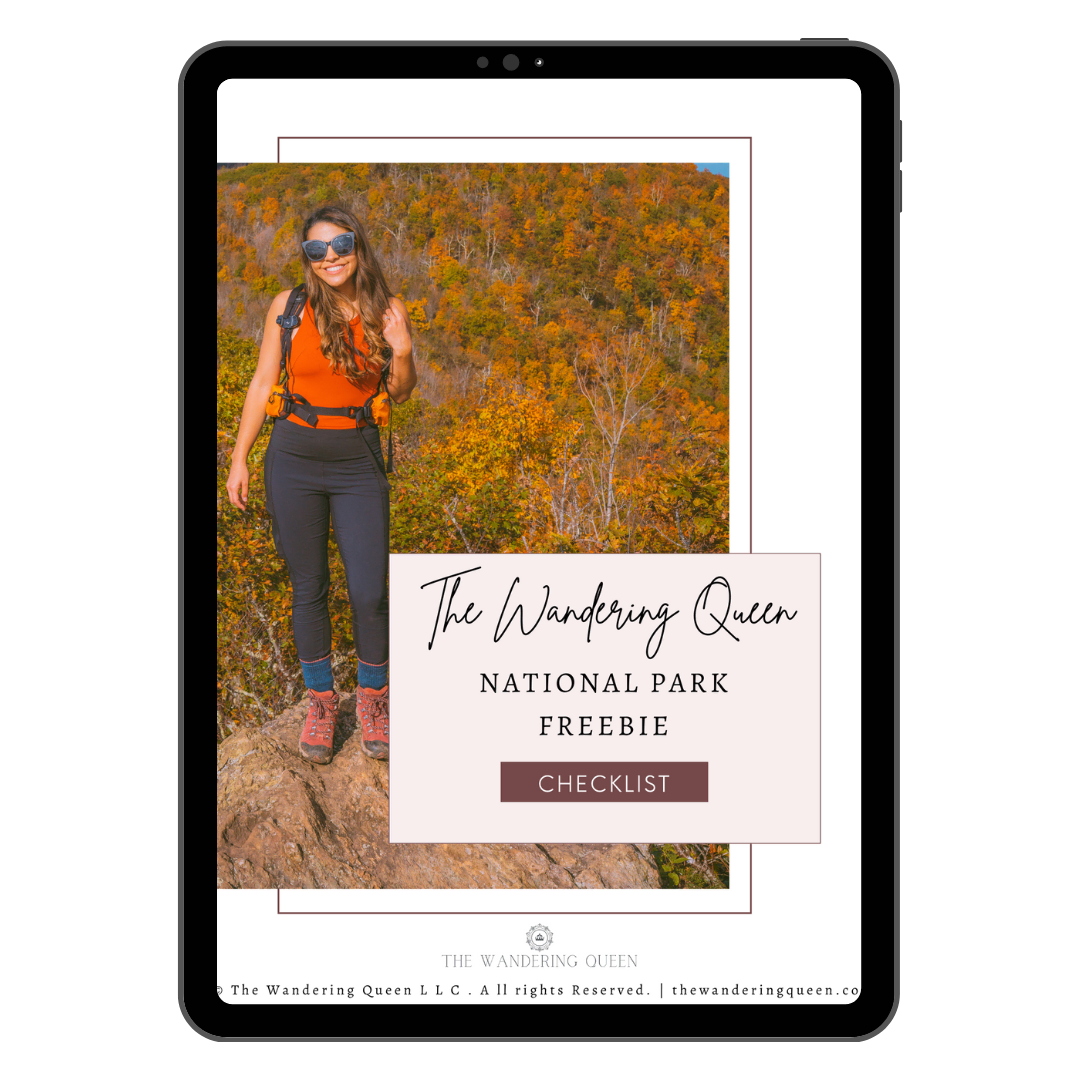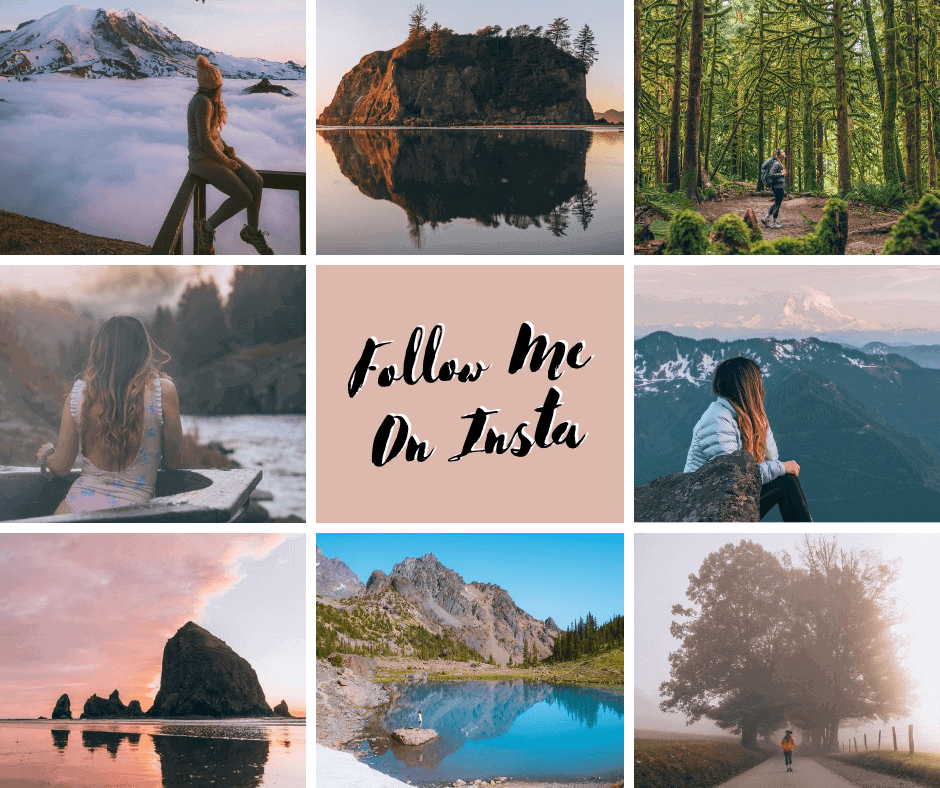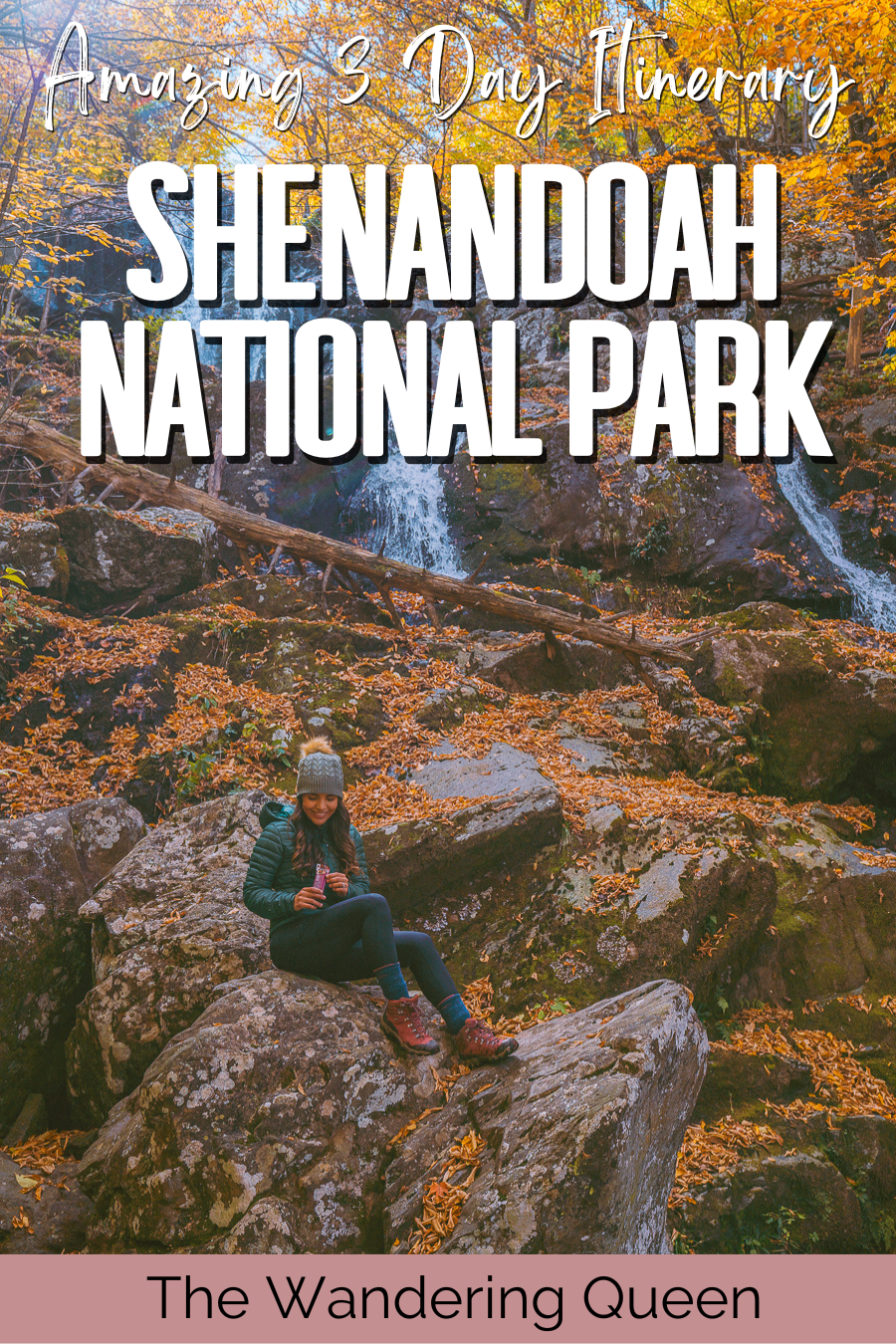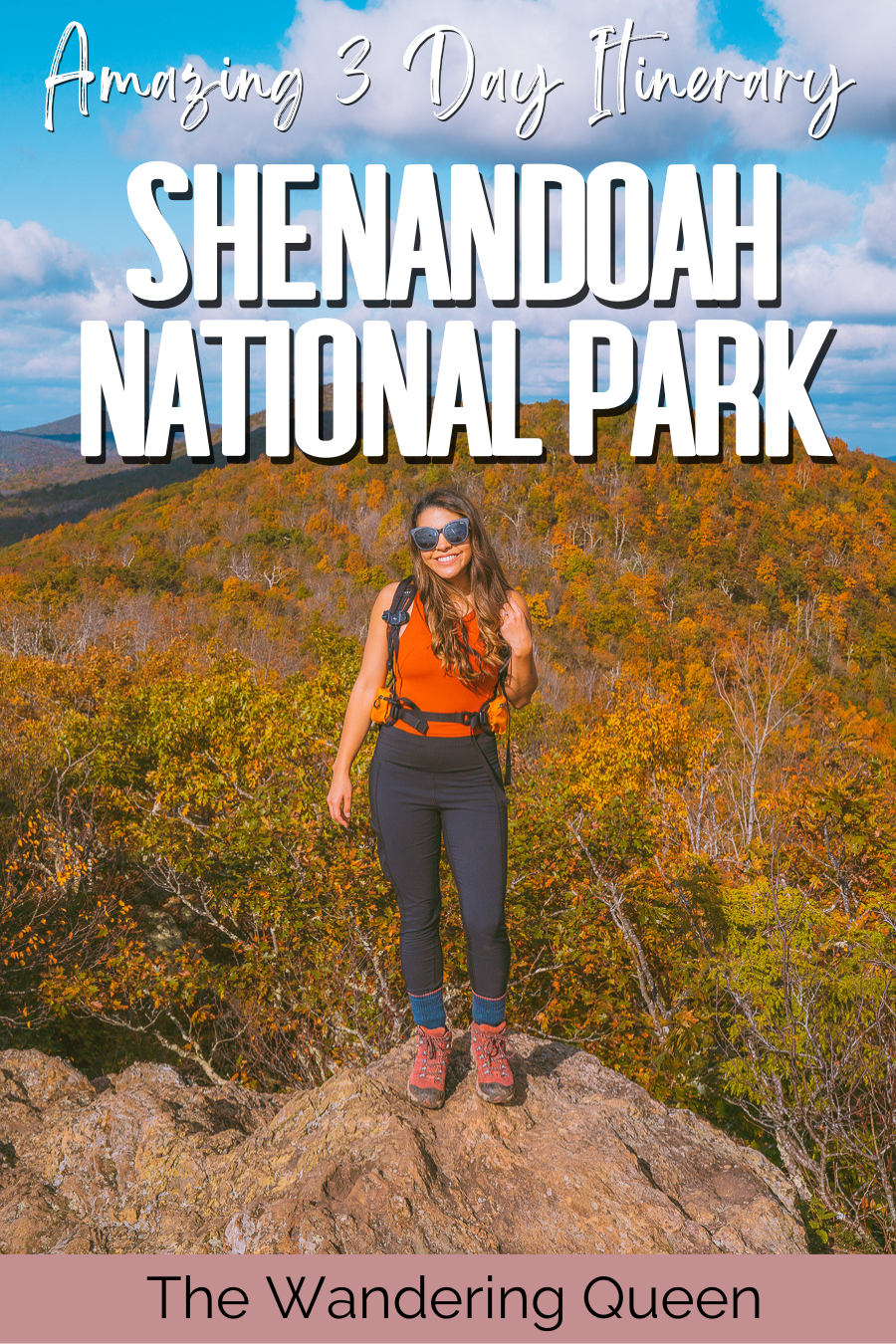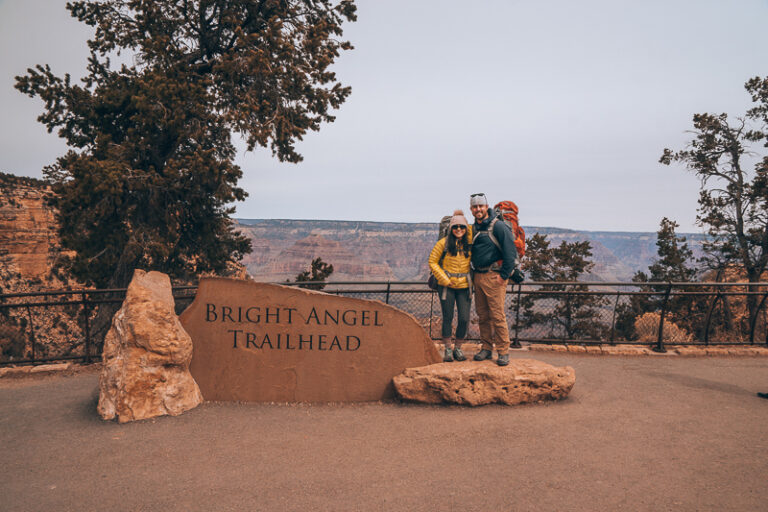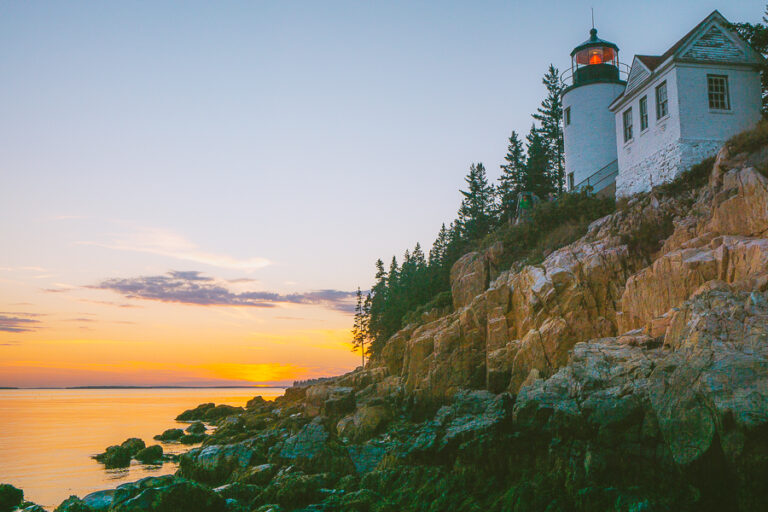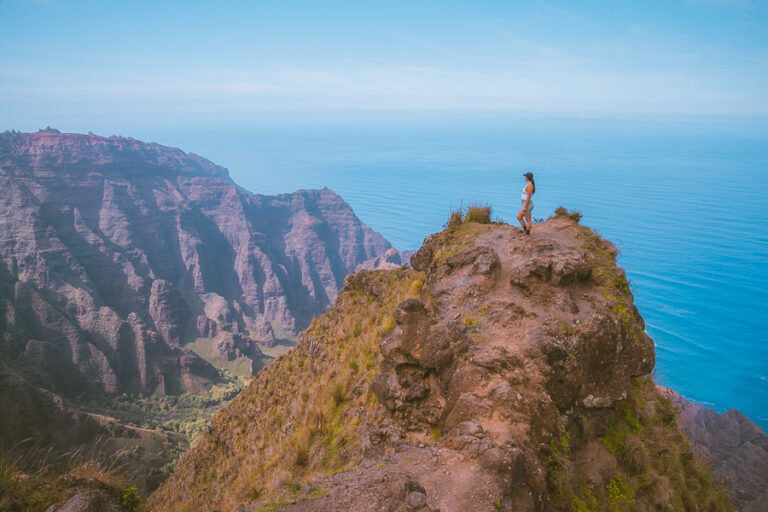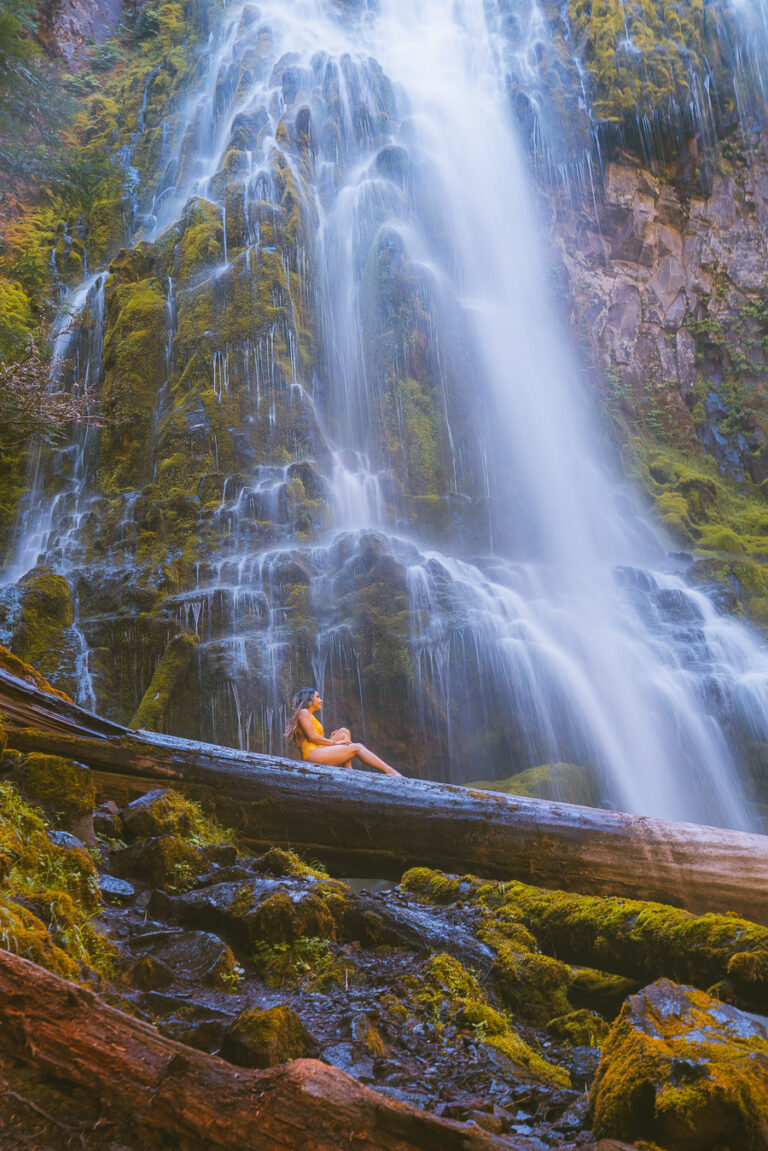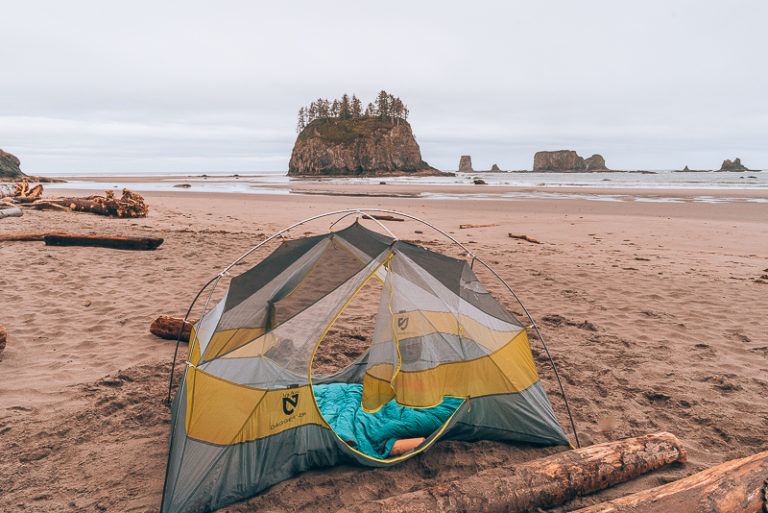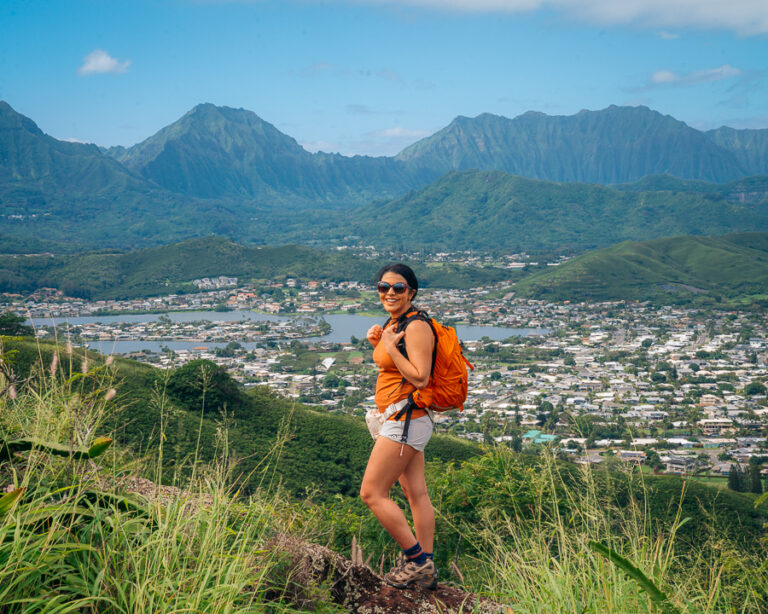The Perfect 3 Days in Shenandoah National Park Itinerary
Shenandoah National Park is one of the few national parks in the US that offers many diverse landscapes, from thick forests to wetlands and tumbling waterfalls. It runs along the Blue Ridge Mountains and traverses a lush valley that lights up in bright colors during fall.
You’ll find plenty of fun things to do in Shenandoah National Park, from trekking across the dense forest to marveling at scenic viewpoints and splashing around in the cascading falls.
This 3-day Shenandoah National Park itinerary covers all of the park’s highlights and attractions not to be missed. You’ll also get insights on the most commonly asked questions about Shenandoah National Park, from the best time to visit and where to stay to how many days you should spend here.
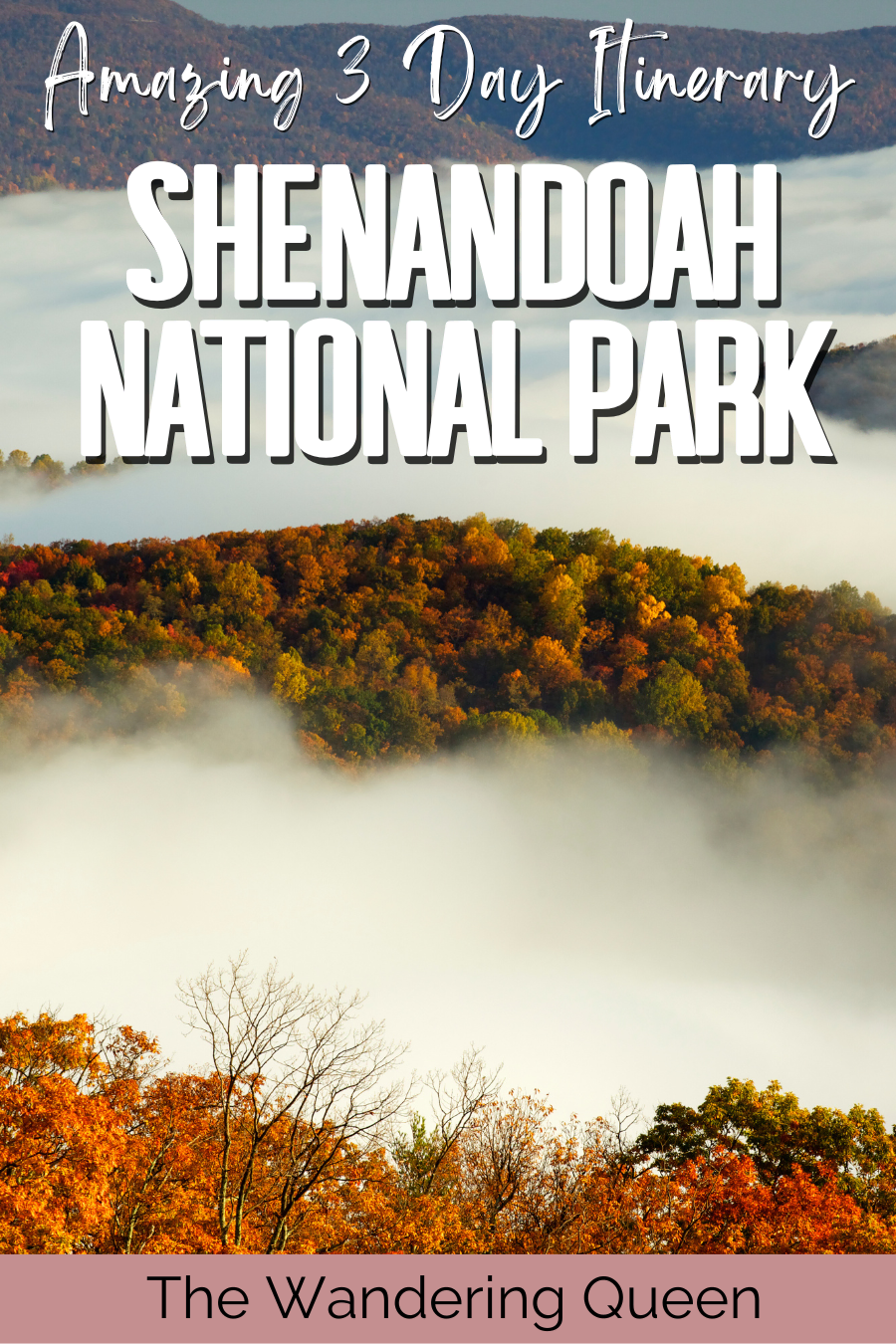
Disclosure: This post contains affiliate links. If you click one of them, I may receive a small commission (for which I am very grateful for) at no extra cost to you.
Shenandoah National Park
Related Posts
How to Get to Shenandoah National Park
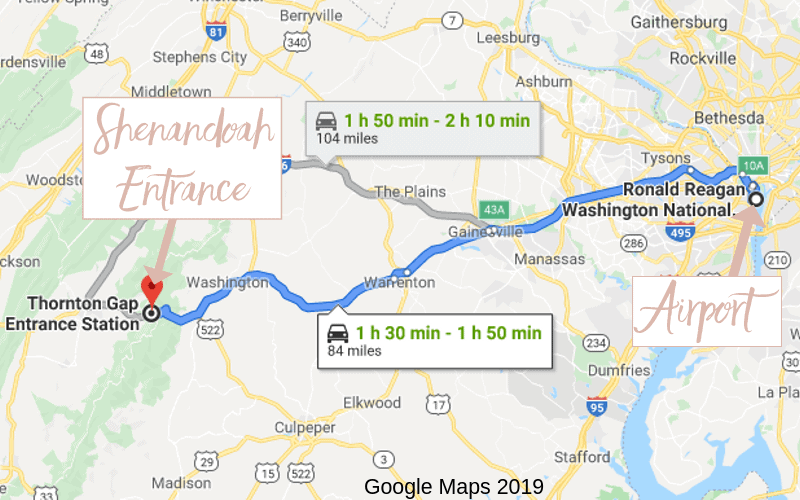
First and foremost, you’ll need to get to Shenandoah National Park before you can explore its best attractions. There are numerous ways you can get here, but the simplest would be flying to an airport near Shenandoah National Park.
The closest one is Charlottesville Albemarle Airport (CHO), about a 30-minute drive to the park’s Swift Run Gap entrance. If you’re coming to the East Coast from other parts of the US, then you’ll need to land at a major airport, and in that case, your best bet would be Dulles International Airport (IAD). It’s about an hour away from the Northern Front Royal Entrance.
Shenandoah National Park Itinerary Map
You can copy and download the itinerary below, but I recommend printing it because you can’t see it if you have no service.
When Is the Best Time to Visit Shenandoah National Park
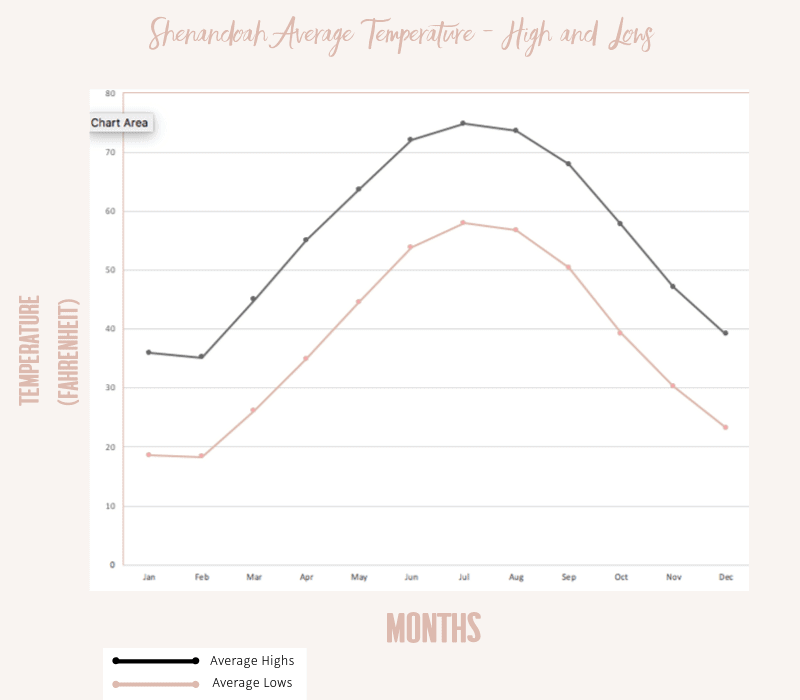
Shenandoah National Park is quite unique in that you can explore it all year round. That said, for an unforgettable experience full of vibrant wildflowers or beaming with foliage, spring and fall are the best times to visit.
Shenandoah National Park in Spring
Spring is an excellent time to visit if you’re an outdoor lover with an obsession for colorful wildflowers. The season typically begins in mid-March through to the end of May. During this time, trees are in full bloom, the birds are out, and the waterfalls are at their most gushing.
Shenandoah National Park in Summer
Summer is another good time to visit for outdoorsy types. The lush greenery is marvelous, and the park’s elevation brings much relief from the sweltering temperatures down in the valley. This season runs from June to August, so schools are out, and ranger programs are in full swing.

Note: Summer is the peak season, so crowds, queues, and limited parking space are all on the menu. Try to visit the park during the week to avoid these issues as much as possible.
Shenandoah National Park in Fall
Fall is another great time to visit, especially if you’re into nature or hiking photography. The park is blanketed with colorful hues of red, orange, and yellow foliage — something that firmly places Shenandoah on the list of the best national parks on the East Coast.
This season begins in late September and ends in November. Similar to summer, fall also draws a lot of outdoor adventurers, so campgrounds are usually fully booked on weekends.
Shenandoah National Park in Winter
Winter is a pleasant time to visit if you want to avoid the crowds. As the leaves fall off the trees, visibility of the valley and beyond is improved. This also helps conditions for wildlife spotting, as deer, birds, squirrels, and foxes forage the land and hunt for food.

Note: Winter brings unpleasant weather conditions at high elevations, usually when it’s raining in the valley. This often leads to the park being covered in snow or ice.
How Many Days Do You Need in Shenandoah National Park
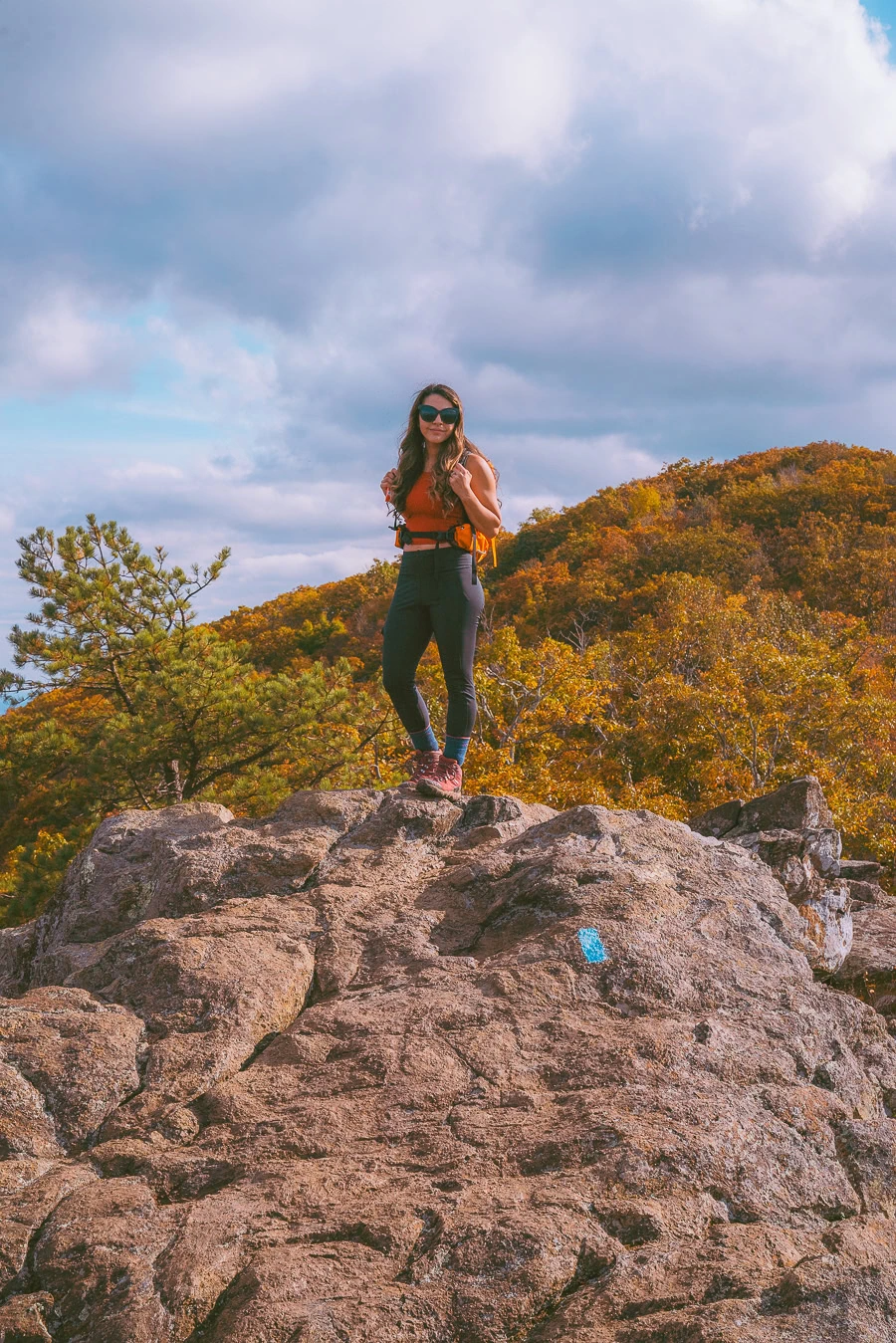
Although it’s narrower than most US national parks, Shenandoah is vast and requires ample time to explore. Three days is ideal, as it gives you enough time to explore the entire length of the park, including its hiking trails, tumbling waterfalls, and campgrounds under star-studded skies.
Where to Stay When Visiting Shenandoah National Park
Since you’ll be spending more than one day in Shenandoah National Park, you’ll need a secure palace to stay. Luckily, there are many towns nearby that provide a range of lodges, from budget-friendly to mid-range and even luxury accommodations.
Here’s a suggested list of where to stay in Shenandoah National Park during your visit:
Budget | The English Inn of Charlottesville
Modestly furnished and boasting spacious rooms, the English Inn of Charlottesville is a great place to stay if you don’t want to break your budget. The hotel features Wi-Fi, a fitness center, an indoor pool, and a buffet breakfast that will have you carrying two plates at once.
If you choose to stay at the English Inn, the park entrances in the south, Rockfish Gap and Swift Run Gap, would be the ideal ways to get into Shenandoah National Park. >>>Check Availability.
Mid-Range | Doubletree By Hilton Front Royal
Beautifully situated under the shadows of the Blue Ridge Mountains, Doubletree by Hilton is an excellent place to stay for easy access to the park’s north entrance. The hotel boasts a rustic interior complete with oak and rock accents.
You’ll enjoy looking out at the Blue Ridge Shadows Golf Club from your room, taking laps around the indoor pool, or soaking in a bubbling hot tub. But what sets this lodge apart is the decadent meals from Houlihan’s, all of which are made from scratch. >>>Check Availability.
Luxury | Graduate Charlottesville
If you’re looking for the utmost sophistication and city views, look no further than Graduate Charlottesville. Sitting across from the University of Virginia, this hotel offers a luxurious stay near Shenandoah National Park.
You can spend time admiring the antique furniture, eating and drinking at the rooftop restaurant and bar, Trophy Room, or exploring other attractions nearby, like the Monticello. >>>Check Availability.
Read More: Where to Stay in Shenandoah National Park – 17 Amazing Hotels & Lodging
Camping in Shenandoah National Park
If you’re keen on an all-encompassing experience of Shenandoah National Park, why not stay overnight at one of its five designated campgrounds? These camping sites open seasonally from early spring until late fall, so you’ll be getting the best scenery.
The park offers you a mixture of reservable and first-come, first-serve sites like the Mathews Arm and Loft Mountain Campgrounds. The Big Meadows Campground is fully reservable, while the Lewis Mountain Campground is strictly first-come, first-serve.
Nothing beats sleeping under the starry night, especially under dark skies. While Shenandoah may not get as dark as other national parks in the west and north United States, the park’s high elevation and low light pollution make it ideal for stargazing. >>>Find Out More.

Tip: To make a reservation for a stay at one of Shenandoah’s reservable camping sites, check out the National Park Service website or visit Recreation.gov.
Shenandoah National Park 3-Day Itinerary
If it’s your first time visiting this stunning national park, you might not know where to kick off your itinerary or even what to do. Well, you’re in luck. This Shenandoah National Park itinerary takes you through the best highlights, hikes, and viewpoints that you shouldn’t miss.
Day One of Your Shenandoah Itinerary
Start your day early so that you’ll have enough time to complete each activity without having to rush it. On day one of this itinerary, you’ll take on some of the best hikes in Shenandoah National Park. Use the Thornton Gap Entrance for a seamless excursion of these hikes.
Catch the Sunrise From Mary’s Rock Summit
- Elevation Gain: 1,210 feet
- Mileage: 3.4 miles (out and back)
- Difficulty: Hard
- Trail Guide: Link
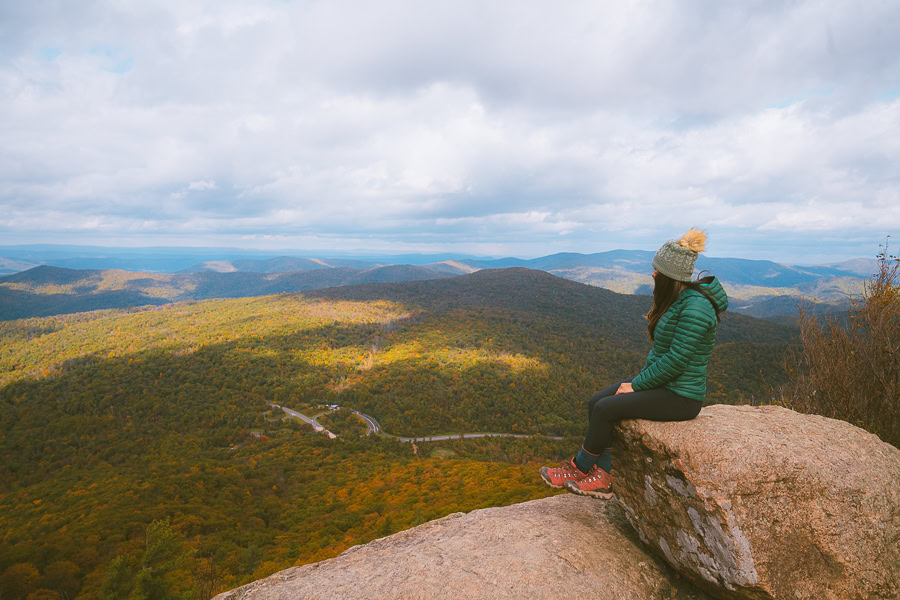
Mary’s Rock is undeniably one of the best hikes in the northern section of Shenandoah National Park. Rising through the dense forest, this hiking trail gives you stunning views of the Shenandoah Valley and ends at a rocky viewpoint.
Begin your trek at the Mary’s Rock Summit Trailhead, located just a few minutes from the Thornton Gap Entrance. From here, you’ll walk a portion of the Appalachian Trail, and after a couple of switchbacks, you’ll begin the ascent to the summit.
As dawn breaks, you’ll witness the sky light up with red and orange hues that paint a colorful picture.

Get our free camping checklist
When you join our newsletter
Hike the Little Stony Man Trail
- Elevation Gain: 807 feet
- Mileage: 3.3 miles (loop)
- Difficulty: Moderate
- Trail Guide: Link
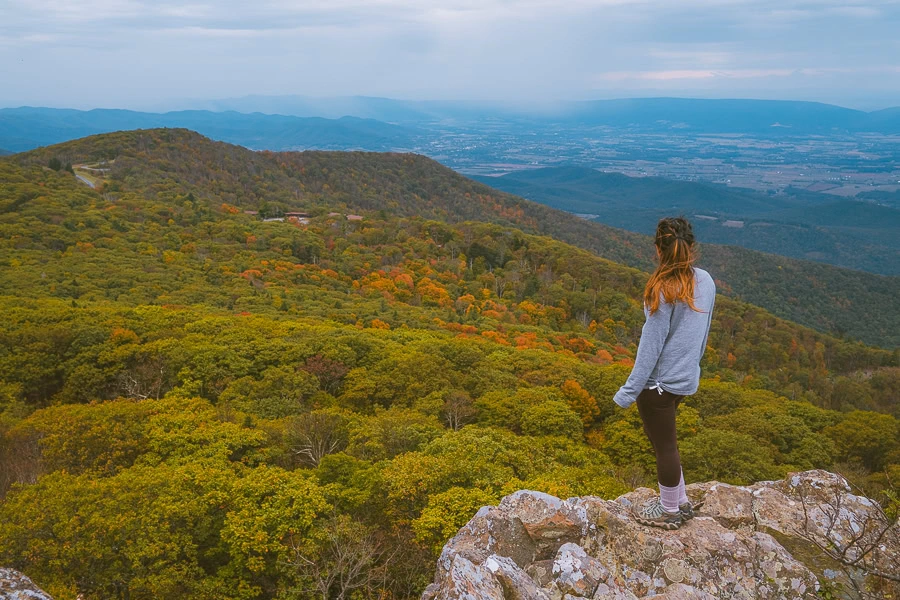
The trek to Little Stony Man is another fantastic hike along the Appalachian Trail. Similar to Mary’s Rock, this hiking trail takes you on an exhilarating climb for panoramic views of the park and the Shenandoah Valley below.
Your hike begins at the Little Stony Man Parking Lot, off Skyline Drive. As you continue along the lush forested trail and you gain elevation, the sweeping views of the park will reveal its beauty.
Chase Waterfalls Along the White Oak Canyon Trail
- Elevation Gain: 2,411 feet
- Mileage: 9.4 miles (out and back)
- Difficulty: Hard
- Trail Guide: Link
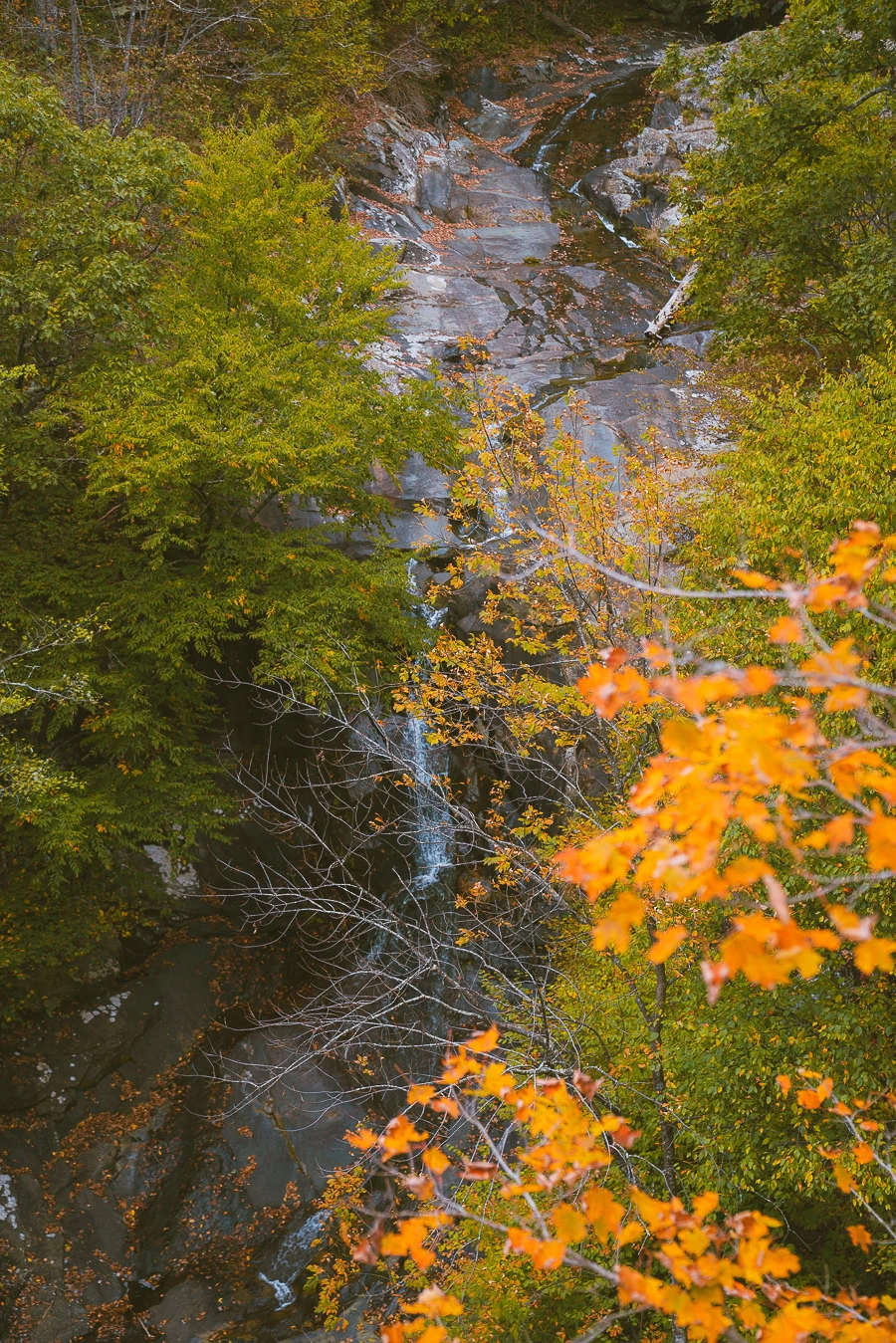
After a long day of hiking, you may want to cool down at a tumbling waterfall — that’s exactly what you’ll get when trekking the White Oak Canyon Trail. Take the Skyline Drive to the Upper Whiteoak Falls Trail. From here, you’ll hike downwards, passing a lush forest dotted with vibrant plant life.
Continue on the trail until you reach the Lower Whiteoak Falls, which are often considered to be the most picturesque. You can do this hike the other way around, starting at the Lower Whiteoak Falls Trailhead, which runs along the Cedar Run Trail.
Day Two of Your Shenandoah Itinerary
On the second day of your itinerary, you’ll take on just one hike. If you’re a hiking enthusiast, don’t despair because you’ll be trekking Shenanadoah’s most famous hike. You’ll also get to see amazing viewpoints and overlooks along the way.
Take a Hike Up Old Rag Mountain
- Elevation Gain: 2,595 feet
- Mileage: 9.3 miles (loop)
- Difficulty: Hard
- Trail Guide: Link
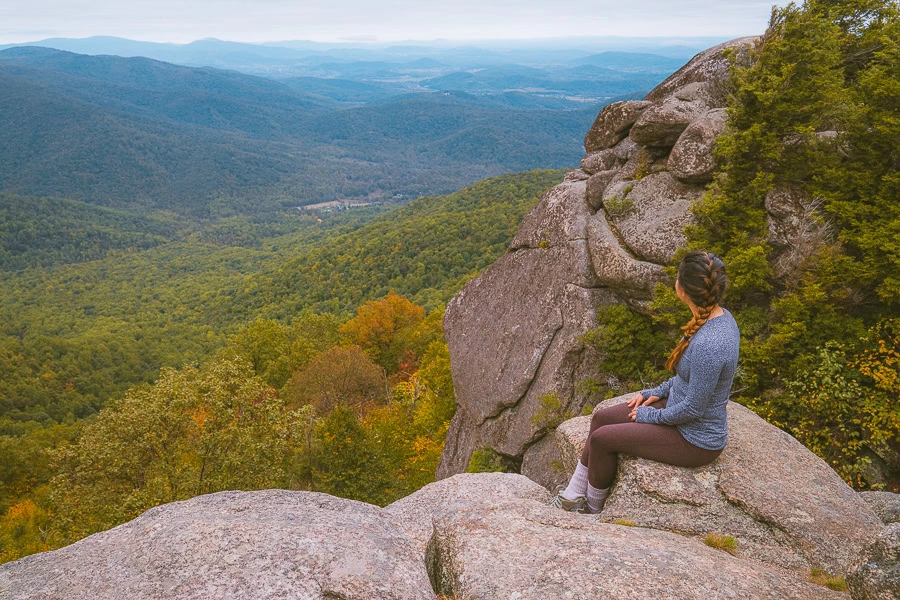
The hike to Old Rag Mountain is an all-day thing due to its length and challenging nature. Not only is this trek among the most strenuous hiking trails in Shenandoah, but it’s also the most dangerous hike in the park. So exercise caution.
While the hike to Old Rag might be challenging, it’s equally as rewarding. After trekking through the thick forest and scrambling over boulders, you reach the summit where expansive 360-degree views of the valley and Shenandoah National Park await.
Make sure you arrive at the Old Rag Parking Lot early (between 6 and 7 am) to secure parking. From here, follow the Ridge Trail for great rock scrambling opportunities about three-quarters into the trek. The beginning of the hike is relatively easy and only has small inclines.
Go for Lunch and Wine Tasting at the DuCard Vineyards
You must be famished after a long morning of hiking and scrambling over boulders. Luckily for you, Shenandoah National Park is surrounded by many wineries that serve picture-perfect vineyard scenery, refreshing wines, and mouth-watering food.
DuCard Vineyards is located about 20 minutes from the Old Rag Parking Area, making it a great spot to stop for lunch. The tasting room offers you an array of wine flights, bottles, and food — all while looking out the Shenandoah mountains through a cathedral-style ceiling window.
Marvel at the Buck Hollow Overlook
Now that you’re re-energized, it’s time to explore some of Shenandoah’s best overlooks. One of them is the Buck Hollow Overlook. This scenic viewpoint offers marvelous scenery of the surrounding mountains and valleys.
You’ll spot Skinner Ridge to the left, Buck Ridge to the right, and the town of Sperryville smack-jab in the middle and far into the horizon.
Stop at the Hazel Mountain Overlook
The Hazel Mountain Overlook sits within a minute’s drive from Buck Hollow, offering more gorgeous scenery. At the viewpoint, you’ll find a series of granodiorite rock formations that give you a wonderful vantage point to look out at the horizon.
From this overlook, you’ll get terrific views of Buck Ridge on the left and Hazel Mountain on the right.
Admire Valley Views at the Stony Man Overlook
Not to be confused with “Little Stony Man,” this viewpoint is among the best Shenandoah overlooks. Why? For starters, it is among the highest points in the park. The Stony Man Overlook provides vistas of rolling hills and panoramic views of the Blue Ridge Mountains.
Wine and Dine at the Pollock Dining Room at Skyland
Wrap up your second day in Shenandoah National Park with a memorable dining experience set against the backdrops of the Blue Ridge Mountains and Shenandoah Valley.
Boasting a rustic charm and expansive floor-to-ceiling glass windows, the Pollock Dining Room at Skyland offers regional cuisine with punchy farm-to-fork flavors. Blackberry Ice Cream Pie is a famous dish, so make sure you don’t go without indulging your tastebuds.
If you’re looking for close-up views of the natural beauty, Terrace Dining is also available. You can head over to the Mountain Taproom for refreshments and some chit-chat. If you don’t have much time, the Grab ‘n Go station is perfect for getting snacks and small meals.
Day Three of Your Shenandoah Itinerary
Last but certainly not least, your final day in Shenandoah National Park takes you through various adventures that encapsulate the entire experience of visiting this national park. You’ll take on some thrilling hikes, stop at scenic overlooks, and cool off at cascading waterfalls.
Hike Up to the Hawksbill Summit
- Elevation Gain: 673 feet
- Mileage: 1.6 miles (out and back)
- Difficulty: Moderate
- Trail Guide: Link
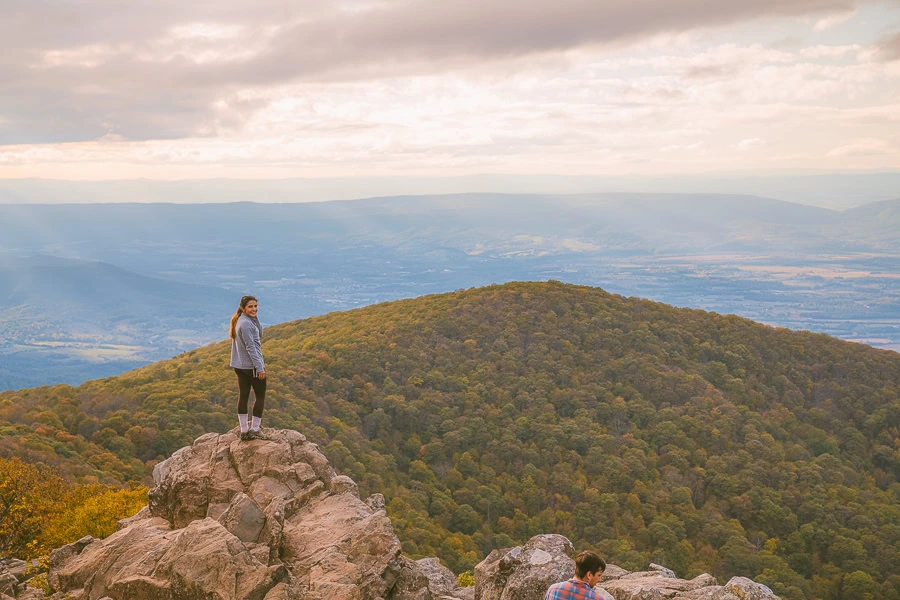
Apart from being the highest peak in the area, the Hawksbill Summit also offers one of the best overlooks in Shenandoah National Park. Although it’s a short hike, the route is steep and moderately challenging. However, the rewarding views definitely make it worthwhile.
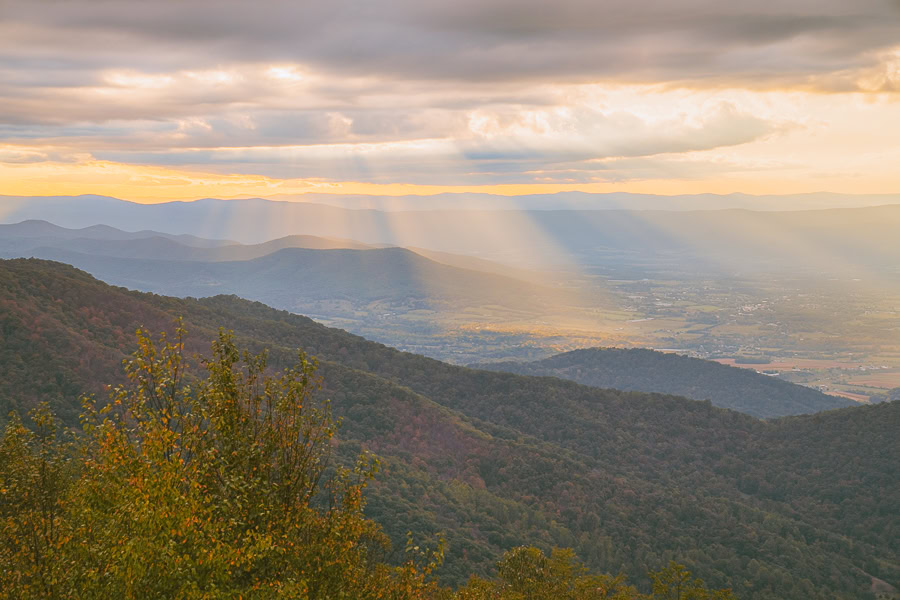
At the summit, you’ll find a viewing platform with magnificent vistas stretching across the Shenandoah Valley, over the Blue Ridge Mountains to the Virginia Piedmont. To get to the summit, you can begin hiking from any of the trailheads along Skyline Drive.
Marvel at the Franklin Cliffs Overlook
Similar to other Shenandoah National Park overlooks, Franklin Cliffs gives you sweeping views of the valley, surrounding peaks, and small towns. This viewpoint is characterized by a rocky outcrop, giving you vistas of Roundhead Ridge and the towns of Stanley and Luray.
Cool Off at Rose River Falls
- Elevation Gain: 876 feet
- Mileage: 3.8 miles (loop)
- Difficulty: Moderate
- Trail Guide: Link
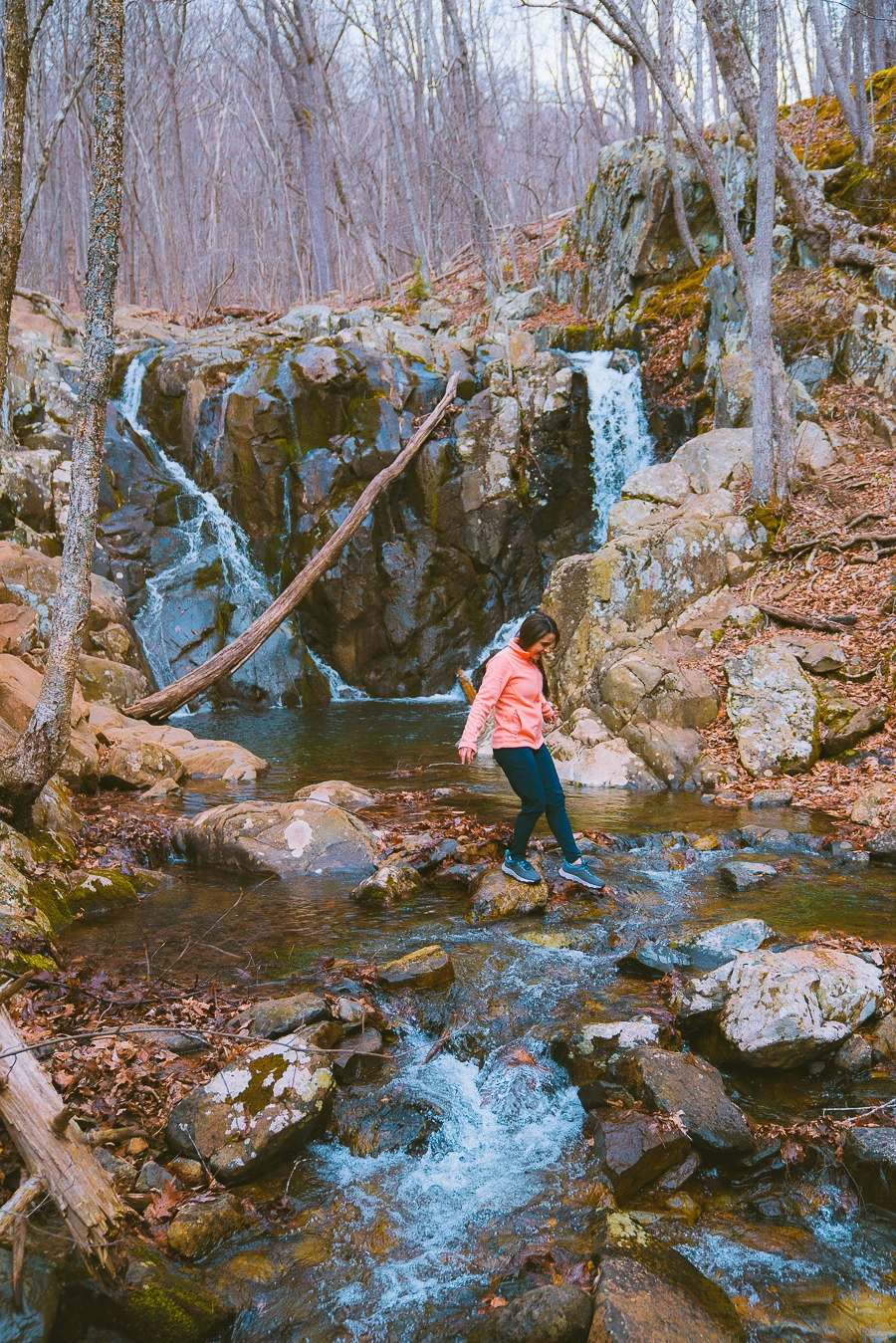
No trip to Shenandoah National Park is complete without taking a waterfall hike. Rose River Falls is one of the finest waterfalls in the park. Boasting multiple cascades and surrounded by lush greenery, these falls offer a serene place to take in Shenandoah’s natural scenery.
Your trek to Rose River Falls also begins along Skyline Drive. From the trailhead, you’ll follow the trail toward the 67-foot falls. After taking them in, you can walk across the bridge, where you’ll combat steep and rocky inclines. A mile later, you’ll be back at Skyline Drive.
Alternative: Make a Stop at Dark Hollow Falls
- Elevation Gain: 584 feet
- Mileage: 1.6 miles (out and back)
- Difficulty: Moderate
- Trail Guide: Link
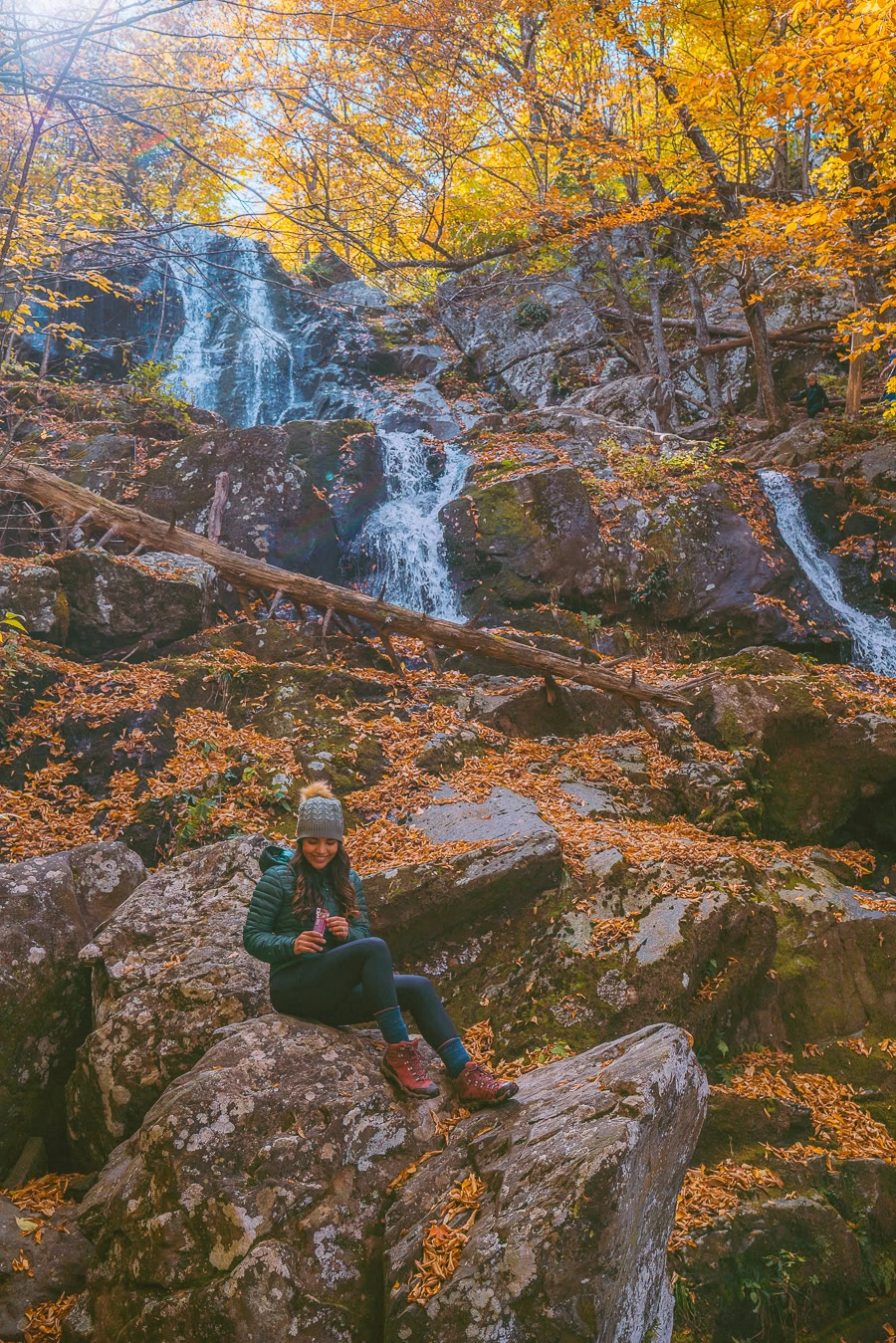
Another superb waterfall you can access via Skyline Drive is the Dark Hollow Falls. Characterized by cascades tumbling over huge boulders and lush vegetation, these falls offer you an excellent spot to dip your feet in the water.
Although it’s short, this hiking trail is steep and rocky. From the Dark Hollow Falls Trailhead, you’ll follow the path along the stream down to the falls. Coming back will be more challenging, with the trail being slippery and wet, as well as climbing up an incline.
Download my free Outdoor Photography Guide
Enjoy The Point Overlook
The Point Overlook is yet another fantastic viewpoint along Skyline Drive, offering more mountain scenery and expansive views of the valley. It’s one of the most visited Shenandoah National Park viewpoints, and it’s not hard to see why.
The Point Overlook features several peaks on its horizon. Powell Mountains is in full display, while the Green and Grindstone Mountains lie in the back. On a clear day, you can also catch glimpses of the town of Elkton.
Scramble Up Bearfence Mountain
- Elevation Gain: 243 feet
- Mileage: 1.0 mile (loop)
- Difficulty: Moderate
- Trail Guide: Link
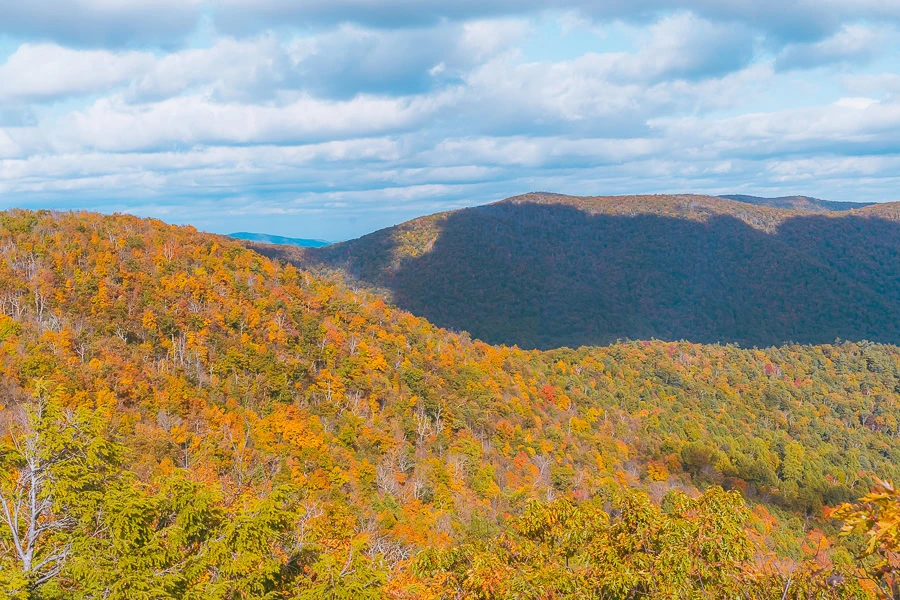
If you’re a rock scrambling enthusiast, climbing in Shenandoah National Park doesn’t get any better than trekking up Bearfence Mountain. This adrenaline-pumping climb sees you scrambling over boulders to get 360-degree views of the park and the valley below.
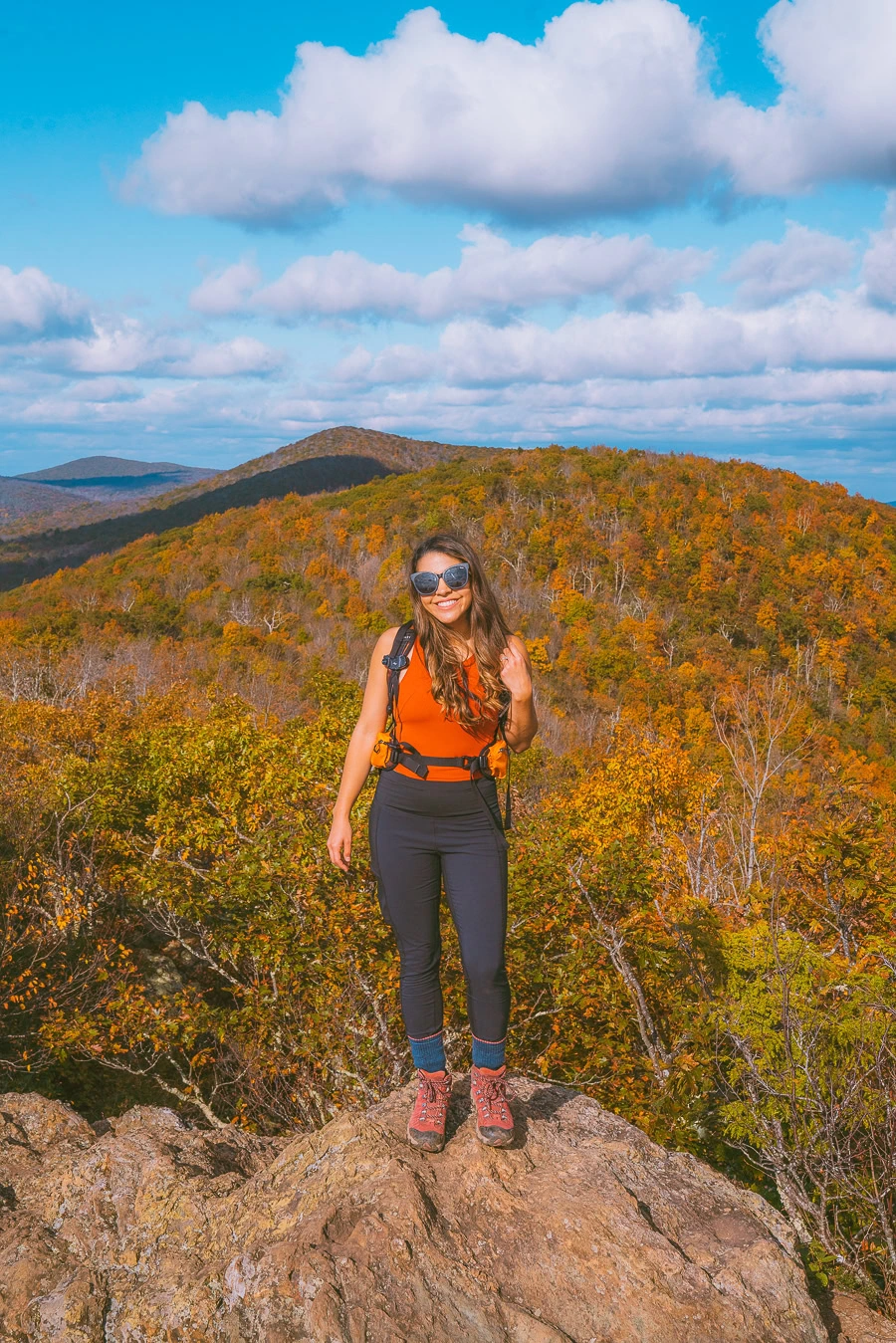
Your trek begins along Skyline Drive at the Bearfence Rock Scramble Trailhead. From here, you’ll walk across the road to the Loop Trail and continue walking towards the rock scrambling part. Take the connector trail and turn right onto the Appalachian Trail to return.
What To Pack For Shenandoah National Park Itinerary
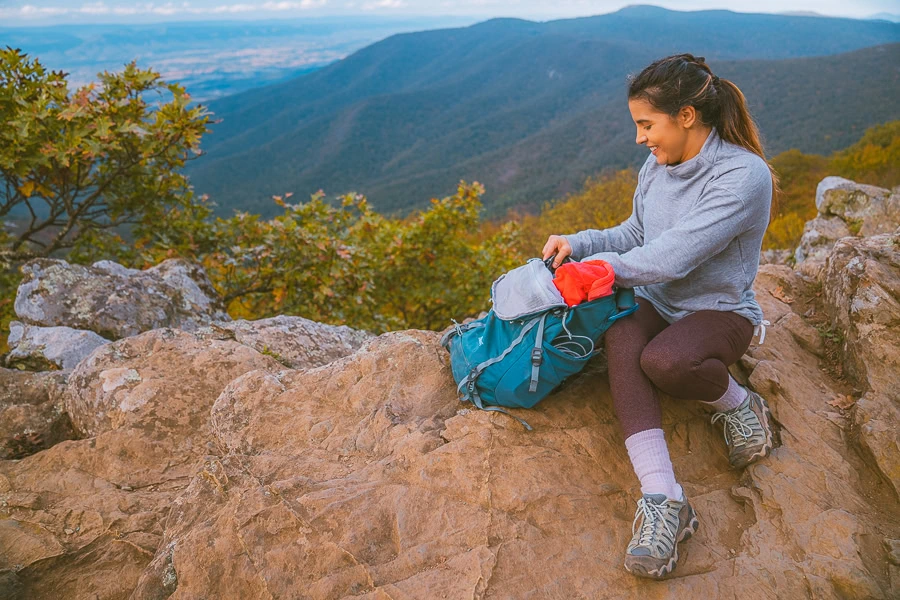
- Sunscreen: One of the ten hiking essentials so make sure to pack this for safety. >Buy Sunscreen
- Hiking Boots/Shoes: If you use tennis shoes you can easily hurt your toes hitting a rock by accident (Trust me I have done it so many times before). >Check Out My Hiking Shoes
- Hiking socks: Having the correct socks helps you prevent getting blisters. Smart Wool is probably my favorite brand out there. I also love how they now have pink socks too 🙂 >Buy Hiking Socks
- Water Reservoir: Water reservoirs help prevent me from getting dehydrated while hiking. The Great thing about this reservoir is that it doesn’t have the plastic taste. >Here Is My Water Reservoir
- Water: Stay nice and hydrated.
- Sunglasses: It can get sunny so make sure to pack some sunglasses. >Check Out These Sunglasses
- Snacks: The best snacks are jerky, nuts, energy bars. Cliff Bars are great for hiking.
- Camera: It was one of the first cameras I started traveling with. The Sony A6000 is an excellent camera for people that want to start improving at travel photography. >Buy Sony Camera Here
- First Aid Kit: This is one of the first things I bought when I first started going on adventures. It is super portable. >Buy This Awesome First Aid Kit Here
- Day Pack to carry all your things: The REI bag I have linked, we have had for seven years now, and it is still going strong! >Buy This Great Quality Backpack
- Headlamp: A headlamp is an absolute must in case you get stranded in the dark! It is a lot more portable and easier to use than a flashlight. >Buy A Headlamp Now
- Leggings or Hiking Pants: Here are the leggings I used in Shenandoah. They are warm and comfortable. They are perfect for fall. >Click For My Fall Favorite Hiking Leggings
- Breathable sweat-wicking shirts
- Sweater: I wore this in the fall when the hikes were very easy and it was a little chilly. >Check Out My Sweater Here
- Sports Bra: For women.
- Jacket: In case you get chilly at night. This is also a good idea in the Spring and Fall. We saw someone get hypothermia on the trail. >Buy My Favorite Jacket
- Tripod: This is an optional item, but it is excellent for getting the ideal sunset pictures. >Check out this tripod
- Knife: I always carry a knife in my backpack just in case. >Check Out My Knife Here
- Map: Explore every trail in Shenandoah National Park with the “Shenandoah Day Hikes and National Park Map Pack Bundle” by National Geographic! This detailed, folded map set is your perfect companion for discovering scenic routes and hidden gems. 🗺️🌿🥾 >Grab yours and start your adventure!
- National Park Pass: If you are an avid hiker like me, it’s worth getting the year-long America The Beautiful Pass. >Get It Here
Claim your FREE Hiking Checklist
Ready to start hiking? Grab my free hiking checklist and never forget anything at home!
Planning a Trip to Shenandoah National Park | FAQs
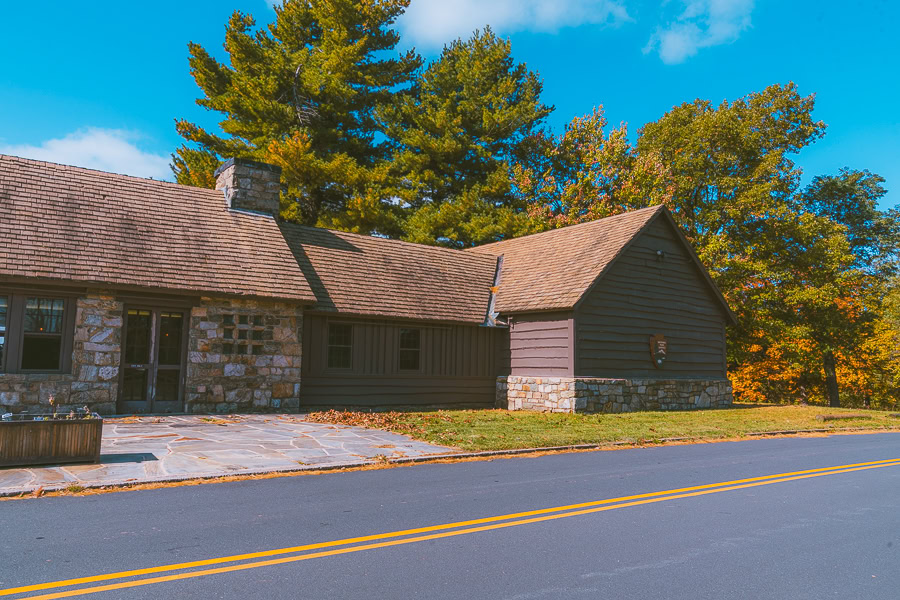
A visit to Shenandoah National Park doesn’t come without its own fair share of challenges. Get ahead of these pesky problems with these frequently asked questions.
What Do I Need to Know Before Going to Shenandoah National Park?
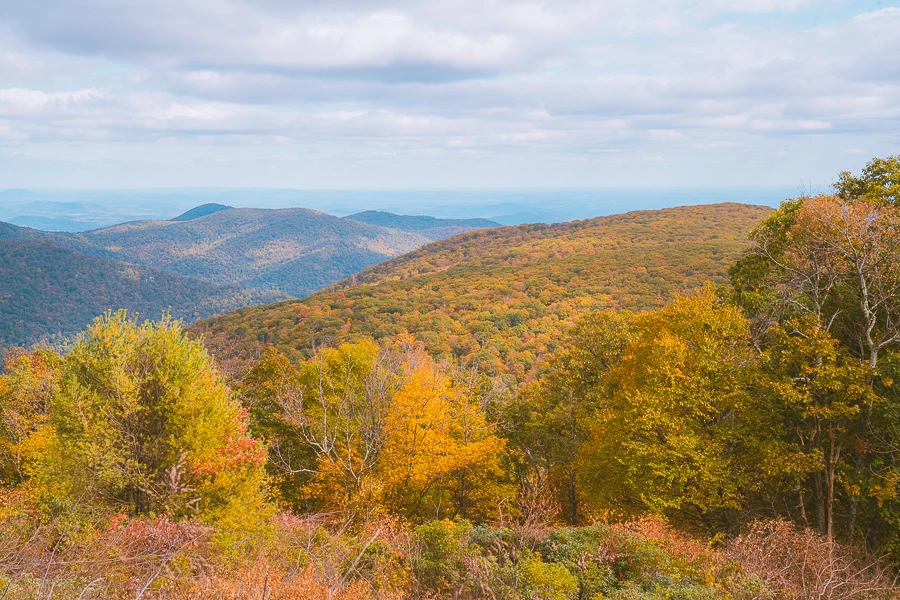
Like any national park in the US, Shenandoah has an array of complexities unique to the recreation center. Here are a few things you should know before you visit:
- The park has four entrance stations: Front Royal, Thornton Gap, Swift Run Gap, and Rockfish Gap.
- You’ll find a couple of visitor centers: Dickey Ridge Visitor Center near Front Royal, and the Byrd Visitor Center sitting across from Big Meadows.
- Old Rag, Whiteoak Canyon, and Dark Hollow Falls are the park’s busiest trails, so the parking lot may be full when you arrive. If that’s the case, move on to another hike and circle back. This is to avoid overcrowding and damaging the landscape.
- If you bring your own food, remember to store it securely, away from foraging wildlife, as this might cause unusual behavior from the critters.
- Lastly, heed all the hiking tips you’ll get from the park rangers. They are more experienced with the landscape and wildlife, so their advice is golden.
How Long Does It Take to Drive the Length of Shenandoah National Park?
The Skyline Drive traverses the park from north to south, along the Blue Ridge Mountains’ crest, for about 105 miles. This is the best way to drive the length of Shenandoah National Park, and it takes about three hours.
Do I Need Bear Spray in Shenandoah National Park?
Yes. Although bears often make a false charge, usually stopping about 10 feet away, it is possible that these animals may attack, so bear spray will come in handy. Make sure you know how to safely discharge the spray before you enter the park.
Wrapping Up the Perfect Shenandoah National Park Itinerary
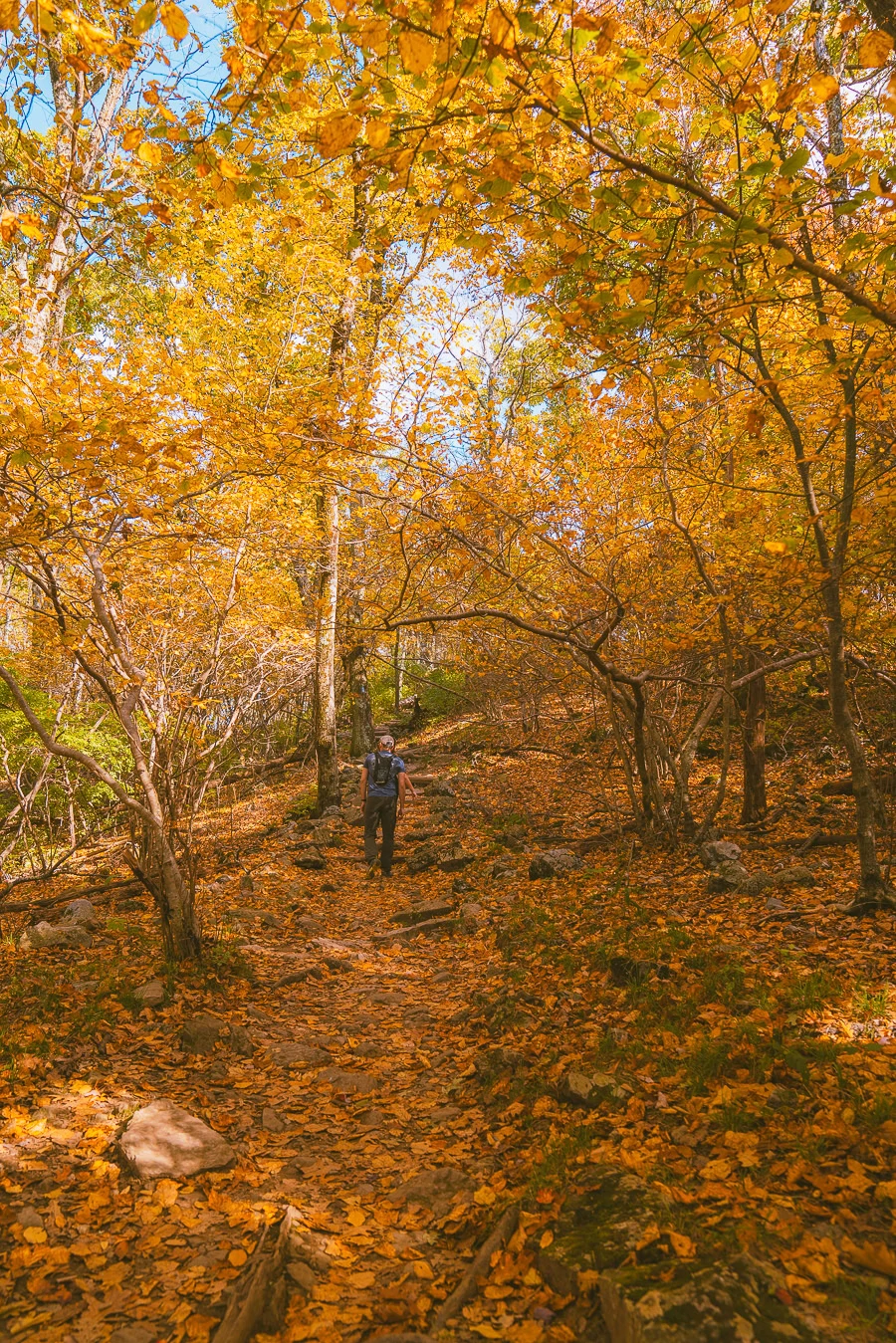
Shenandoah is among the best national Parks in the US, and it’s not hard to see why. From hiking through lush, forested trails to splashing in waterfalls and taking in sweeping views of the surrounding peaks, Shenandoah has all you need for a great national park trip.
Whether you’re looking for short hikes that end with rewarding vistas or rock scrambling adventures to the highest point of the park, this 3-day itinerary has you covered.

